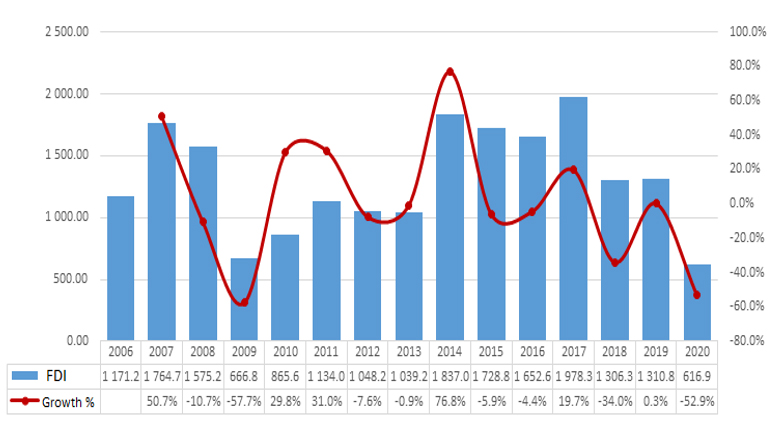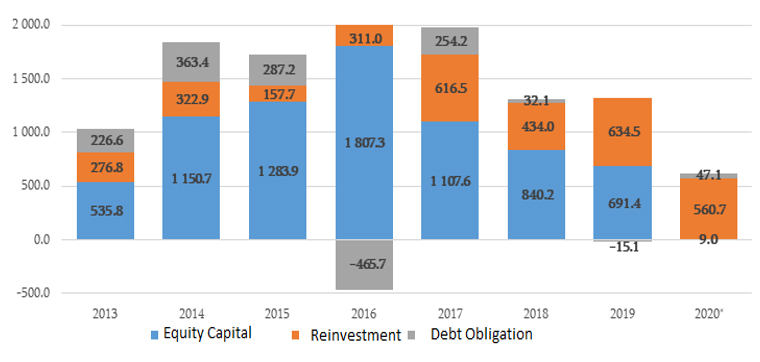Gigla Mikautadze: “Investments are at 15-year low and such a drop in investments did not even happen in the war period.”
Verdict: FactCheck concludes that Gigla Mikautadze’s statement is MOSTLY TRUE.
Resume: The volume of foreign direct investments to Georgia in 2020 dropped by 52.9% and amounts to USD 616.9 million. The claim that investments are at 15-year low is true. However, the biggest drop in investments happened precisely in the post-war period. In 2009, a year after the war, the volume of foreign direct investments to Georgia was USD 666.8 million which is 57.7% less as compared to 2008’s figure.
The analysis of the changes in the FDI to GDP ratio would be relevant for a comprehensive analysis of the FDI trend. However, the reporting period (2005-2020) includes the years where GDP calculations were made under a different methodology and, therefore, the figures are not comparable.
The share of re-investments in 2020 accounted for 90.9% of the total foreign direct investments. The amount of foreign direct investments made in equity capital is USD 9 million which indicates that basically no new investments were made in the country which is correctly reflected in Gigla Mikautadze’s statement.
Analysis:
Gigla Mikautadze, one of the leaders of the Lelo for Georgia political union, stated that “foreign direct investment figures are at a 15-year low.” Mr Mikautadze also explained that the pandemic objectively affected the investments, although such a drop in investments did not even happen in wartime. He also added that “investments in equity capital amount to only USD 9 million which means that foreign investments simply were not made in Georgia and foreign investors limited themselves only by re-investing their profits made in Georgia. Of additional interest is that the financial sector accounts for 65% of foreign investments and in fact foreigners have not made new investments in other fields.”
According to the preliminary data, the volume of foreign direct investments to Georgia in 2020 is USD 616.9 million which is 52.9% lower as compared to the final figures of 2019.
Of note is that the volume of foreign direct investments in Q4 of 2020 amounted to USD -102.8 million meaning that there was an investment outflow from Georgia. The transfer of several companies from non-residents to residents was named as a key driver behind this drop. This reason has been routinely used by the government to “justify themselves” whilst speaking about the declining foreign investments. However, the authorities’ providing only “technical” aspects (paying debts, completion of the BP pipeline project, etc.) as a counter-argument to explain the declining FDI dynamic may be speculative. Usually, when FDI was on the rise in the past years, attention was not paid to such details. A part of the investments has previously been outflowing from the country (debts were paid and companies were sold), although these outflows were offset by other inflows which could not be done in the past years. Therefore, the pointing out of technical reasons does not absolve the authorities of their responsibility.
Graph 1: Foreign Direct Investment Volume (USD Million) and Growth Rate (%) [1]

Source: National Statistics Office of Georgia
The re-investment share in 2020 amounts to 90.9% (USD 560.7 million) of the total foreign direct investments. Debt obligations are USD 47.1 million whilst the FDI made in equity capital is USD 9 million. Such a high re-investment figure illustrates that basically no new investments were made in the country.
Graph 2: Foreign Direct Investment Volume (USD Million) Based on Constituent Components, 2013-2020

Source: National Statistics Office of Georgia
Of the total amount of foreign direct investments, 64.9% (USD 400.3 million) was made in the financial sector, 16.5% (USD 101.5 million) in the mining industry and 11.6% (USD 71.8 million) in real estate. The rest of the foreign direct investments made in all other sectors accounts for 7% of the total FDI. Of note is that the volume of foreign direct investments in the energy field decreased by USD 255.8 million and amounts to USD 5.8 million. Energy was the largest sector in terms of foreign direct investments in 2019 and ranked second only behind the financial sector. Foreign investments in the hotel and restaurant sector decreased by USD 341.7 million and amounts to USD -221.5 million.
It is certain that such a sharp drop in the foreign direct investments in 2020 is directly linked with the pandemic. However, the investment volume had also already been declining in the pre-pandemic period.
[1] To assess the foreign direct investment dynamic, it would be relevant to analyse the FDI to GDP ratio. However, these figures cannot be compared to those dating before 2010 given that the GDP has been calculated with a new methodology since 2010.








